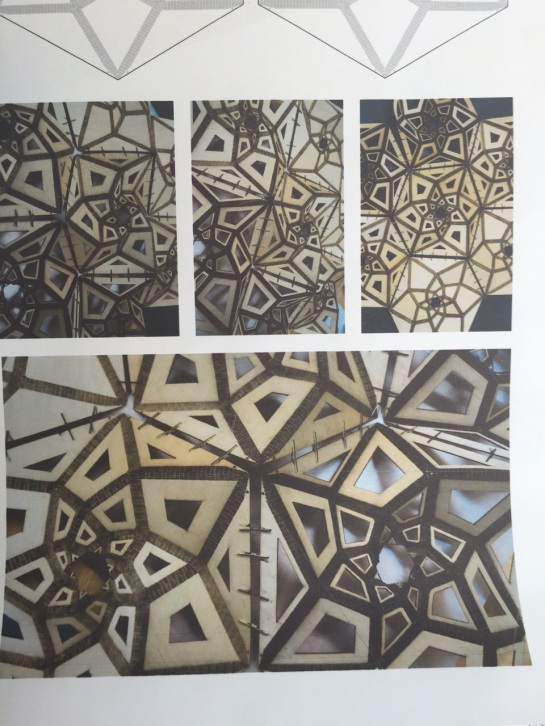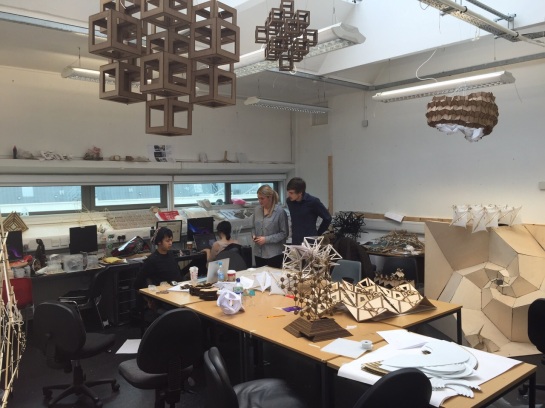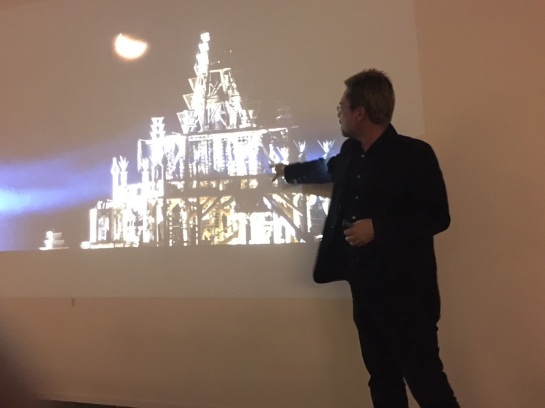





































































































The Fractal Hourglass counts down to the singularity, the moment that artificial super-intelligence triggers an unprecedented shift in human civilisation. The concept of recursively self-improved AI is portrayed by a tower of iterated fractal trusses, in which time is measured by a cascade of light.
Triangular steel trusses array to form a 15-foot tall hourglass silhouette, where scaled repetitions within each truss form a lattice of increasing complexity and infinite bounds. The visual density of each truss intensifies at each fractal iteration, culminating in the filling of the lower hourglass bulb, representing the finite time remaining until the singularity. At night, a dynamic cascade of LEDs will flow on and off from the upper to the lower bulb, a spectacle alluding to sand pouring through an hourglass.

The steel tubes forming the piece range from a diameter of 1.5″ in lengths from 1 to 3-feet, which are hammered flat and bolted to form the main structure, and 0.5″ diameter tubes welded inside to form the decorative fractal repetitions.

On approach, the tense drama of time running out is visible through the concentration of material in the bottom of the hourglass, provoking an instinct to stall the process. Burners have a choice of how to experience the hourglass- whether that is to ascend the structure to experience the inversion of the hourglass as the bulb empties, where ascension serves as a sanctuary from the saturation of technology and AI in the lower bulb. Or they can recline on the ground and let their eyes weave through the layers of trusses and bathe in the saturation and complexity of technological advancement. Or simply to turn away and let what effectively has become a natural process to take its course. At night, the cascading light display forms an even more immersive encounter with the hourglass, as waves of light repeat the process of time as it funnels through and fills the lower bulb, swarming anyone who is inside.
The finite nature of fractals in the hourglass represents the capacity for infinite artificial intelligence- each increment provides an equally stable steel structure, whilst having the capacity to use less and less material, but only to a point. It is not possible for this fractal to reach infinity and be constructed at a human scale. This poses the question of, at which point on the way to infinity do humans get before their intelligence can be overtaken by AI- the moment of the singularity. Is it too late to invert the hourglass and, given the choice, would you want to?
The Fractal Hourglass allows for Burners to take a moment to relish on their existence as humans, with the capacity to orchestrate their own experience, something which AI’s currently don’t possess. Artificial intelligence is currently an opportunity to shape a future experience where humans can outsource themselves, freeing up valuable time and energy. The hourglass serves as a visual symbol that human existence is fleeting so long as AI is permeating our lives, and provides a timer for the impending singularity, a moment that will transform the world as we know it, a reminder that we still have the alluring capacity to define and create.
‘The first ultra-intelligent machine is the last invention that man need ever make, provided that the machine is docile enough to tell us how to keep it under control.’
I J Good
Some joyous proposals for both Burning Man and Buro Happold’s London office at yesterdays crit, the first of the year.
Our guest critics were Andrew Best, James Solly, Andrei Jipa, Harry Charringdon and Ben Stringer. Thank you all for your inspiring comments and tireless enthusiasm throughout the day.
Here are some images of the exciting work coming out of the studio this year, more to come 🙂















We are approaching the first “crit” of the term and our students are already proposing joyful projects for the Burning Man festival and Buro Happold’s newly refurbished HQ on Newman Street. The talented photographer NK Guy (http://nkguy.com/ and http://burningcam.com/) gave an excellent evening lecture at our campus to inspire our students and for the release of the book “The Art of Burning Man” (Taschen) which will feature some of our studio’s work. Here are couple images of the student’s project and of our buzzing DS10 space (pictures by Toby Burgess):












Another great tutorial day this Thursday. Here are two projects that are materializing into beautiful models. The first project is by Sarah Shuttleworth, it is a simple folded component which drives a curved surface that is used both as furniture and shelter, the other project by Henry Turner is a series of intersecting plywood waves which create a playful landscape on which people can lounge.
Here are couple pictures taken during the two last tutorial sessions. Promising breakthroughs from several students. Time to create a believable proposal (including large model and drawings) for Burning Man or any other festival.



Great Thursday tutorials at Westminster! Thank you to former DS10 students George Hintzen, Joe Magri and Chris Mount for their presentation on their trip to the Burning Man festival last summer. We have just started Brief02: Template. Students will start designing a temporary structure for the Burning Man festival or an Open-Source Construction Set.
 Above: Jessica Beagelman’s beautiful laser-cut plywood experiments
Above: Jessica Beagelman’s beautiful laser-cut plywood experiments
 Above: William Garforth-Bless scanned his ferofluid and will turn them into inhabitable fountains
Above: William Garforth-Bless scanned his ferofluid and will turn them into inhabitable fountains
 Above: Sarah Shuttleworth’s beautiful swarm generated wood structures
Above: Sarah Shuttleworth’s beautiful swarm generated wood structures
 Above: George Hintzen, Joe Magri and Chris Mount presenting their Burning Man experience
Above: George Hintzen, Joe Magri and Chris Mount presenting their Burning Man experience